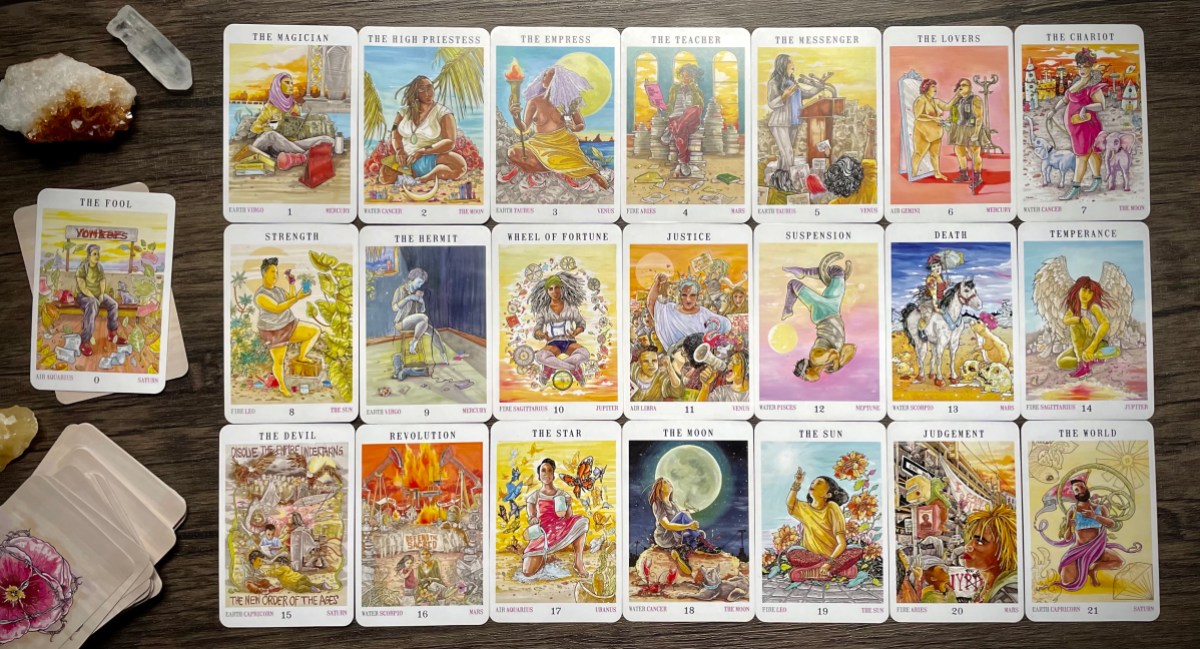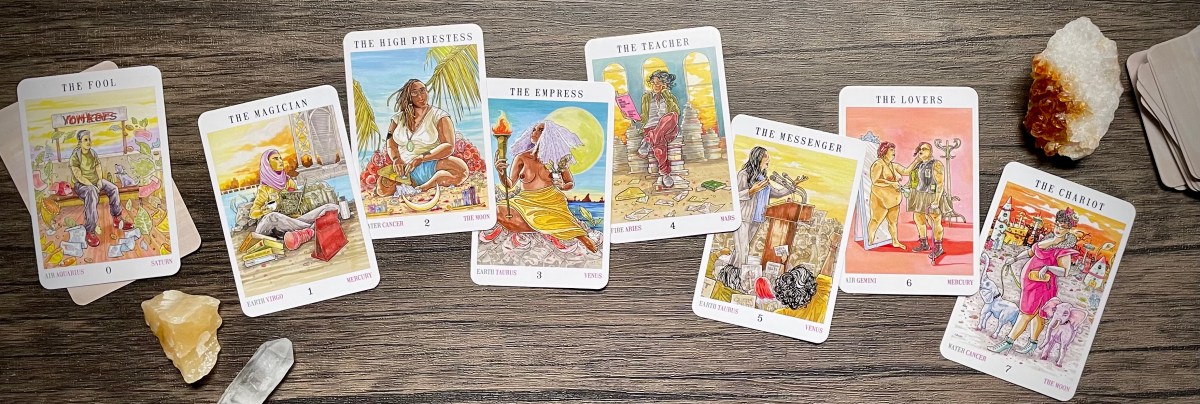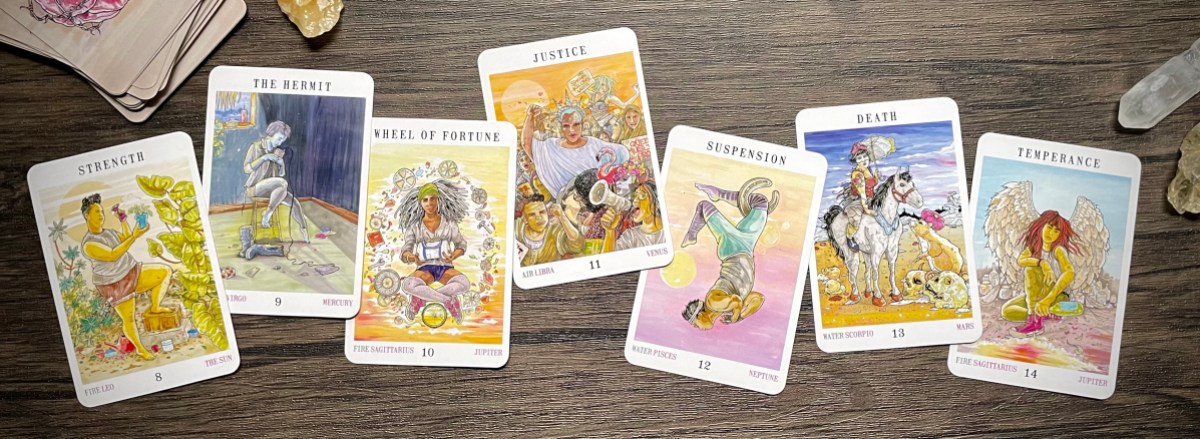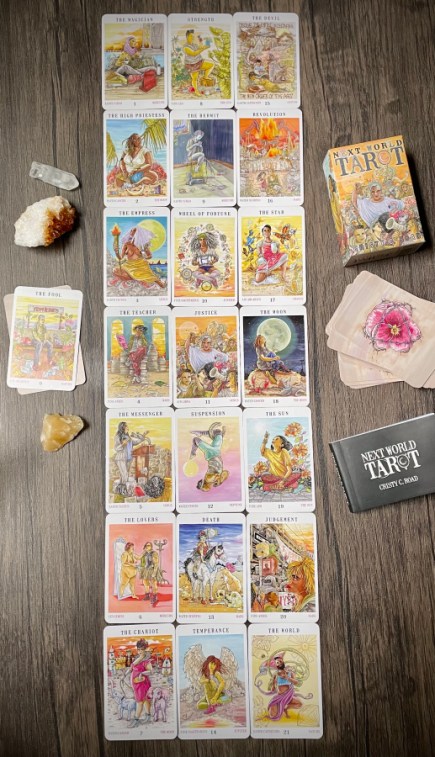This post features cards from the Next World Tarot by Cristy C. Road.
When diving into the major arcana of the tarot, that classic Fool’s Journey of 22 archetypes and teachers and pivotal moments, it can be overwhelming to look at these larger-than-life figures and begin to unpack what they might mean for you. Each of these cards offers endless depths of meaning, tradition, and associations — and especially if you’re just getting started, you may worry that you’ll never be able to read without multiple books or sources by your side.
Fortunately, tarot cards have been around for hundreds of years, and in that time a lot of brilliant scholars and thoughtful researchers have given us a variety of methods for working with this tool. There are a lot of different ways to dig deeper into the major arcana, like looking at astrological and numerological correspondences, paying attention to elements and energies, or simply working with the cards one at a time. Analyzing the majors as one giant, winding story may feel like an immense undertaking — but if we start to break this journey into smaller chunks, taking these archetypes one line at a time, it becomes a bit more manageable. And in grouping the cards together in a few different ways, we can understand the full story more clearly, and can also find new levels of nuance and magic within our tarot readings.
The major arcana is made up of 22 cards, but the very first archetype, the Fool, is assigned the number zero. Zero is the number of beginnings and endings, of infinite potential and boundless freedom, existing everywhere and nowhere all at once. When we translate that energy to the Fool, we find a figure that exists outside of the rest of the majors; an archetype that, as Rachel Pollack says, serves as “the animating force giving life to the static images” of the other cards. The Fool begins the cycle that is the major arcana, serves as our avatar though this cycle of evolution, letting us follow along on their strange and wondrous adventures. The journey cannot exist without this figure, yet we can find this energy dwelling between every card in the major arcana, intertwined throughout every shift and choice. At its core, the Fool is the energy and intention that propels us forward.
Because the Fool is so distinctively different than the rest of the deck, in looking at the major arcana as a whole it makes sense to let this card stand apart. And in setting the Fool to the side, we are left with 21 archetypes: 21 figures, 21 stories, 21 energies.

In laying out these 21 cards, we can immediately sort them into two different groupings: three groups of seven cards each, or seven groups of three cards each. By looking at each of these sets of groupings, we can start to note similarities and patterns, and tug on the collective threads that link these archetypes together.
Traditionally, the three phases of the major arcana are defined as such:
- The Self / Personal Awareness (Magician through Chariot, cards 1-7)
- The Collective / Personal Influence (Strength through Temperance, cards 8-14)
- The Cosmic / Personal Evolution (Devil through World, cards 15-21)
In viewing individual cards through this lens, you can dig more deeply into definitions and interpretations, and find personal meaning in each of these cards. Traditional understandings of these cards are important, but the ways that you identify and connect with these cards also hold a lot of value — and if you’ve been struggling to understand how each separate archetype contributes to the full story, this can be a useful place to begin.

In the first line, we take time to understand who we are, what we want, the things that drive us and the dreams that inspire us. This is a time of self-discovery, of personal awareness, that helps us find our place and purpose in the world.
- We begin with the Magician, a figure of rich potential and boundless opportunities, who celebrates the Fool’s big idea and shows them all of the resources they can access, all of the magic they carry, all of the paths forward they can follow.
- The High Priestess helps the Fool practice discernment, listening to their intuition and inner wisdom as they choose between these various paths, giving themselves space for reflection and awareness before acting.
- Once the path has been identified and selected, the Empress offers joyful abundance, creative expression, rich manifestation as this idea begins to become tangible and take up space in the world.
- The Emperor (known as the Teacher in this deck) takes all of that raw goodness and helps to clarify and refine it, introducing structures of safety and foundations of stability that help us continue to build with intention and ambition.
- The Hierophant (known as the Messenger in this deck) introduces the Fool to traditions and history, showing them what kinds of ideas have come before, encouraging them to be a student and collaborate with others even as they expand and explore.
- The Lovers urge freedom, giving the Fool access to rich partnership and reminding them that they are allowed to break free of the old ways, that gathering information and personal experience has deep value.
- And the last card in this row, the Chariot, shows us breaking free of established boundaries with intention, protecting ourselves even as we shift into a new method of growth and creation.

In the second line, we begin to tap into a deeper understanding of how our actions, choices, and ideas impact the people and systems around us. We recognize our place in society and the world, understand the influence we can have, and learn to navigate different methods of belief, movement, and change.
- Strength reminds us that speed is not always the most valuable thing, that sometimes we need to take time to ponder and plan before moving forward rather than letting ourselves get swept up in the opinions of others.
- The Hermit shows us the value of stepping away from the collective at times, gives us the ability to ask ourselves the hard questions and prioritize self-discovery even when surrounded by brilliant, inspiring people.
- The Wheel of Fortune taps into collective cycles, reminding us that we are a small cog in a large machine, that what goes up must come down again.
- Justice helps us recognize the need for equality, fairness, ideals, and shows us the difference between believing something will work and seeing how it actually plays out in the world.
- The Hanged One (known as Suspension in this deck) is us coming up against a roadblock that we cannot navigate, forcing us to stop and surrender, to give up any illusions of control even as the world keeps moving around us.
- Death brings loss, a permanent shift, a natural and inevitable end to a relationship, dream, situation, or belief, forcing us to grieve and grow.
- Temperance, our final card in this line, represents a time when we are learning to find moderation between what we want and what we need, establishing our place in the world in a way that sustains and nurtures us.

The final line becomes more spiritual, less clearly grounded in the world we live in and more concerned with our evolution on a cosmic scale. These cards feel larger than life, broad and deep: they push us to consider the ways that we embrace transformation, the times that we allow ourselves to grow in response to our experiences.
- The Devil pushes our limits, asks us to consider the destructive behaviors and indulgent choices we make that challenge and stimulate us, forces us to identify how much control we really have over anything.
- The Tower (known as Revolution in this deck) is a grand collapse, the recognition that the old foundations we established for ourselves are no longer functional or useful, a breaking free from old constraints or beliefs or ambitions.
- The Star is hope and healing, a new perspective on our future, an opportunity to leave the rubble of our old life behind and begin to pursue something that is in deeper alignment with who we are.
- The Moon represents dreams and fears, illusions and fantasies, the wildness that we so rarely allow ourselves to explore and the ways that our imagination alters our perceptions of the tangible world.
- The Sun is celebration, abundance, the integration of the brightest and deepest parts of ourselves, a sense of powerful contentment in our present even as we sense the change on the horizon.
- Judgement offers true awareness, forgiving our mistakes and misunderstandings, being willing and able to fully step into a new, evolved version of ourselves and leave that old self behind without regrets.
- And the World, that complex and elusive archetype at the end of the major arcana, is a full and complete acceptance of who we are, a release of fear, a celebration of all of our gifts and magics.
People spend their entire lives studying these archetypes and still find new things to uncover and unpack, so if this feels overwhelming, don’t fret — you’re not alone. But in seeing these distinct lines as phases within a larger cycle, as beats in a complex and joyful evolution, we can find new meaning within them. If the Lovers feels out of reach, put it into the context of personal awareness, of the ways that partnership and community and information-gathering help us understand who we are and who we are not. If the Hanged One doesn’t resonate, remember its place in the cycle of personal influence, and consider how stopping when the rest of the world keeps moving around us changes the course of our work, play, and growth cycles. If the Moon leaves you baffled, think about its role in personal evolution, the ways that our fears and fantasies help us expand our vision of what is possible, the comfort and discomfort that collectives have with the things we cannot fully define or understand. Placing these archetypes in the context of their line in the majors gives us a new lens to view them through.
In the same way, laying the major arcana out in these rows of seven also creates groupings of three, each of which have fascinating commonalities.

- The first group of Magician / Strength / Devil shows us potential: potential for expansion, potential for steadiness, potential for destruction. What we choose to do with that potential is up to us.
- High Priestess / Hermit / Tower are all moments of choice: will we reflect, will we isolate, will we flee chaos or will we find freedom within that chaos? How do we handle multiple options, and when are we forced to adapt?
- Empress / Wheel / Star are moments of deep awareness and hope, as we understand how we show up in the world, and allow ourselves new perspectives on what we have to offer. Each of these cards gives us a glimpse of abundance, of possibility, of connection.
- Emperor / Justice / Moon examines existing systems, challenges what they can be, and asks what happens if we leave them behind entirely. How do systems protect us, and when do they stifle us? How much power do we really have over the foundations we use?
- Hierophant / Hanged One / Sun asks us to be entirely present, and to consider how growth, stagnation, and celebration occur in moments of awareness. What do we learn about ourselves when we simply observe?
- Lovers / Death / Judgement represents times of permanent shift, when our consciousness evolves and we begin to see the world through an entirely new lens due to connection, loss, or forgiveness. Each of these cards offers us a different kind of freedom.
- Chariot / Temperance / World, our final trio, shows us what can happen when we’re willing to learn from what we have endured and experienced, the deliberate choices we can make when we take everything into consideration and honor boundaries, balance, and self-love.
Again, you might find different threads that connect these groupings — or you might not resonate with what I’ve written here at all, and instead have different keywords, definitions, discoveries that link these cards together. But in giving yourself the chance to play around with these different groupings, to find the similarities and differences between them, you can begin to create meanings that resonate with you, and understand what these different archetypes may be able to offer.
Which of these types of groupings do you resonate with the most? How do putting the cards together in different ways help you find similarities between them? What does the act of separating the major arcana by phase or line emphasize for you? Which other grouping systems do you like to use to understand tarot in new ways? Do any of these groupings feel hard to relate to or not make sense? Let me know in the comments!



I don’t know why no one has commented on this article — cause it’s great. Thanks for breaking this down so thoughtfully.
This article is so insightful and really help me get to know the major arcana better. On a different level even. Thank you for expanding my tarot practice and readings.
Thanks so so much for this article. It was so insightful and informative. Iam new to tarot cards and this gave me a place to start and I now feel alot more confident in do readings. But I know there is so much more for me to learn. I appriciate how easy this is to understand. Thanks again… I will be back.